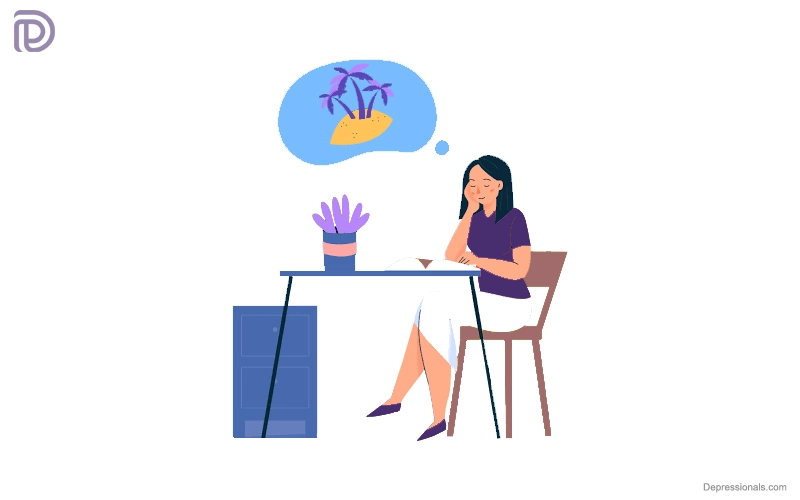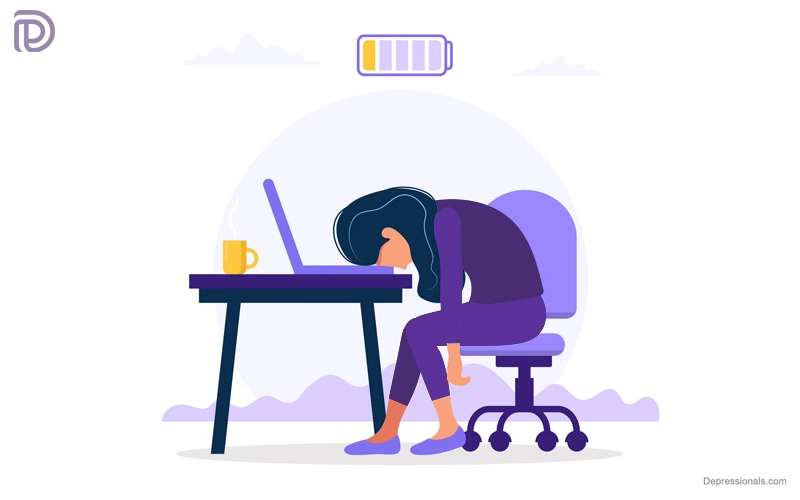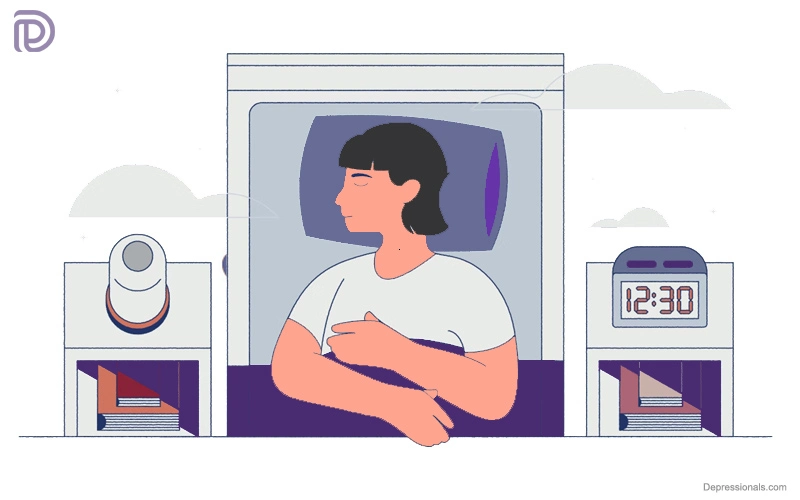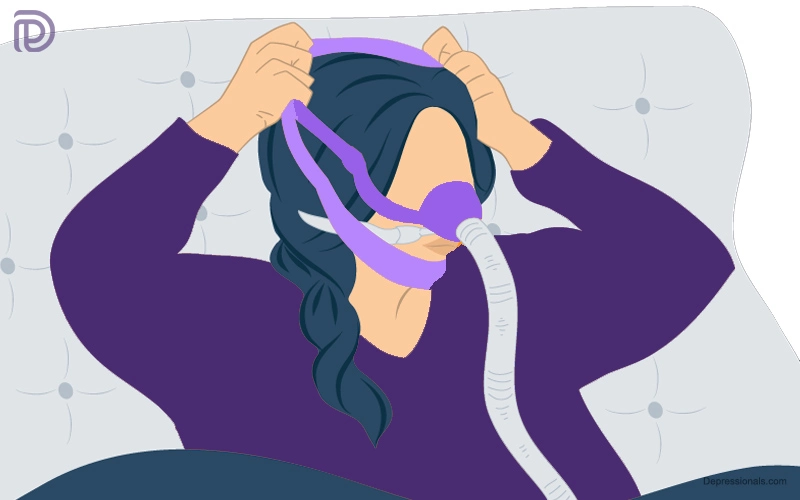Once in a while, it is common to lose yourself in your thoughts. The average person spends about 47 percent of their waking hours daydreaming, briefly distracted from the world around them while their mind wanders. You may be experiencing maladaptive daydreaming if it interferes with your daily life.
Some people have a habit of daydreaming on a regular basis. Daydreams are common for some people, and they interfere with their everyday tasks.
What is maladaptive daydreaming?
Maladaptive daydreaming, sometimes called a daydreaming disorder, occurs when a person experiences extreme daydreams that are clearly distracting – so distracting, actually, that the person stops participating in what they are doing. In real life, daydreams are triggered by various factors such as noises, smells, conversations or movies.
Daydreamers with maladaptive behaviors may dissociate from reality and become completely immersed in their daydream, unconsciously displaying the actions or speaking the dialogue of the characters in a daydream. There is much detail and fantastical content to the daydreams. While some feature a distorted idealized version of the daydreamer, others have been compared with soap operas.
Traumatic stress may lead to maladaptive daydreaming. When people experience trauma in that world, they often feel safer than when they experience it outside.
For example, during the COVID-19 lockdown people who are maladaptive daydreamers were more likely to engage in this behavior. The vividness of their daydreams intensified, and they were no longer able to control their daydreams.
The diagnostic and Statistical Manual of Mental Disorders (DSM-5) does not yet recognize maladaptive daydreaming as a mental disorder. People with anxiety, depression, or obsessive-compulsive disorders are more likely to engage in maladaptive daydreaming. Most maladaptive daydreamers suffer from some type of mental illness.
Read: Central Sleep Apnea
Who does it affect?
Those with mental health conditions or conditions that affect the function of specific types of brain functions are most likely to develop maladaptive daydreaming. There are a number of conditions that are associated with maladaptive daydreaming, including:
- Attention deficit hyperactivity disorder (ADHD)
- Anxiety disorders
- Certain types of depression
- Dissociative disorders
- Obsessive-compulsive disorder (OCD)
It is also worth mentioning that aging can also contribute to maladaptive daydreaming. The study indicated that it is more likely to occur in younger people – especially young adults and teenagers – than in older people. It has also been shown that children can also experience it. There is still a need to perform more research in order to determine whether it is more common or less common according to the age of the person.
Additionally, there are many individuals who experience maladaptive daydreaming as a result of abuse or trauma during their childhood, especially a history of abuse or trauma. It is important to note, though, that maladaptive daydreaming is not something that all people are afflicted with.
Symptoms
There is no defining list of symptoms for maladaptive daydreaming, which is because it is not yet defined as a medical condition. A person may also experience one or more of the following symptoms:
- Immersive and vivid daydreams
- Long and difficult daydreams
- Inability to fulfill everyday tasks
- Daydreams are triggered by external circumstances, such as listening to music or watching a movie
- Insomnia and sleep disruption
- Movements where you rock back and forth while daydreaming or twitch
Those with attention deficit hyperactivity disorder may also exhibit some of the signs of this condition, such as short attention spans.
Complications of maladaptive daydreaming
It is possible to dissociate from the world around us when we experience maladaptive daydreams because such experiences can be so immersive and prolonged that it negatively impacts our relationships, work performance, sleep, and daily activities. Researchers have found that medical students whose daydreaming was maladaptive had a markedly lower grade point average.
In an average day, a maladaptive daydreamer spends 4.5 hours daydreaming. It might be so hard for them to stay grounded in reality as they become absorbed in their inner world. Daydreamers may fail to care for their relationships and obligations in the real world as a result of the all-consuming nature of their daydreams, causing them emotional distress. People generally feel worse emotionally after daydreaming, even though they have a strong desire to do so.
Daydreamers who are maladaptive may spend 4.5 hours a day worrying about their daydreams. It may become harder to ground themselves in reality if they become so absorbed in their inner world.
Daydreamers are more likely to have sleep problems, whether they do so maladaptively or not. When one does not receive sufficient sleep, the ability to focus, concentrate and pay attention is impaired, which is a symptom of maladaptive daydreaming. The result of a disturbed night’s sleep may then lead to a day of daydreaming that is unproductive.
Sleep disorders are often accompanied by dissociation, another symptom associated with maladaptive daydreaming. Furthermore, disorders like anxiety and depression, which are associated with this condition, are also related to poor sleep.
Read: Psychophysiological Insomnia
Maladaptive daydreaming test
When physicians want to determine whether a person is maladaptively daydreaming, Professor Somer created a 16-item test. This test asks questions about:
- Daydream triggers
- Daydream physical signs
- Feelings associated with daydreaming
- Interruptions that affect daydreaming
- Negative consequences of the inability to dream
- Effects on the daily life of daydreaming
- Listening to music while daydreaming affects daydreaming
From zero influence to 100 influence, each question is scored.
Diagnosis
Maladaptive daydreaming currently does not have a specific diagnosis, nor is there a universal method for diagnosing it. You can use some tools to check whether you experience this condition. Tests for maladaptive daydreaming feature 16 items you can take to determine if you are experiencing it. It is a tool for self-reporting experiences that you provide.
Your doctor may also use other tools to determine whether you are experiencing symptoms of:
- Dissociation
- Obsessive-compulsive disorder (OCD)
- ADHD
- Often occurs in conjunction with maladaptive daydreaming.
Read: Chronic Insomnia Disorder
Maladaptive daydreaming in ADHD
Researchers have linked maladaptive daydreaming with ADHD. The findings of a study conducted in 2017 examined 39 individuals with the disorder. More than 77 percent of the participants had disordered daydreaming as well as ADHD.
According to some experts, in 2020, ADHD should not be viewed only as a behavioral issue, but rather as a condition that affects the inner life of the individual.
The internal presentation of this disorder is maladaptive daydreaming. This can interfere with your motivation and productivity in the classroom and at work. According to the researchers, women are particularly susceptible to this problem. ADHD and maladaptive dreams are both associated with sleep disturbances.
Difference between daydreaming and maladaptive daydreaming
Everyone daydreams occasionally. They’re almost always pleasant, but they can occasionally be irritating. Even though they can distract us from the task at hand, they have a variety of benefits, such as allowing us to plan out our future, relieve boredom, understand the meaning of our lives, and boost our creativity.
Themes of maladaptive daydreams are often associated with violent, power-driven, control-oriented, sexist or rescue-oriented themes. Daydreams that are maladaptive frequently devolve into fantasy, unlike typical daydreams.
Furthermore, while normal daydreams are purely mental, maladaptive daydreaming involves an immersive experience that often involves repetitive facial expressions, movements and verbalizations.
Read: How Pandemic COVID-19 Affects Our Dreams
Treatment and management
Maladaptive dreams do not have a standard treatment. However, some techniques can help manage symptoms derived from anecdotal evidence.
Some of these techniques include:
- Reducing fatigue: You can improve the quality of your sleep by increasing the amount you sleep. The use of stimulants such as caffeine may also help combat fatigue during the day.
- Know your symptoms: You might be able to get someone to interrupt the daydreaming if they know about your symptoms.
- Know what triggers you: An individual can identify activities or stimuli that trigger maladaptive daydreaming by keeping a diary of when it occurs.
- Consider therapy: Maladaptive daydreaming can be identified by identifying the underlying triggers. CBT can help uncover any issues at the root of the problem. Your therapist may also recommend helpful coping strategies.
- Taking medications: People who experience this condition are unlikely to need medication for it. This condition may be eased by a medication known as fluvoxamine.
Fluvoxamine helped manage maladaptive daydreaming in one case study. Nevertheless, there is not much evidence to support the use of drugs in treating it.
It is hard to manage highly structured daydreams or fantasies that occur as part of maladaptive daydreaming. There may be a feeling that you are trapped in a complex world with many characters. Despite this, it’s also important to realize that this isn’t the real world.
Read: Circadian Rhythm Sleep Disorder
What are the effects of this condition on my body?
There is a problem called maladaptive daydreaming that can have a negative effect on your mind. Your mind consists of all the memories, experiences, thoughts, beliefs, emotions and more that you and only you have, which are unique to you and can be accessed by no one else. The mind and the brain are not the same things. It is your brain that generates all the elements that make up your mind, and your brain is a physical part of your body, which generates all these elements.
It has also been speculated that maladaptive daydreaming may also be the result of unique brain structures that some people lack and others do not. ADHD patients have a small, but still significant difference in the size of certain parts of their brains that are smaller than those of non-ADHD patients. It is usually the areas of the brain that are responsible for executive functions such as decision-making, planning, and motivation that are involved in these tasks.
The overlap between maladaptive daydreaming and ADHD is due to the fact that people with maladaptive daydreaming often struggle with executive function problems. It is also difficult for them to manage their own emotions. People with maladaptive daydreaming may also have brain differences similar to those of people with maladaptive sleep. It will take more research for experts to confirm whether this is true or not.
Bottom line
Researchers don’t understand why maladaptive daydreaming occurs. Having difficulty coping with everyday challenges, past trauma, or another condition like ADHD can all be explanations. Maladaptive daydreaming cannot be diagnosed or treated specifically.
The treatment of OCD and anxiety may be helped by cognitive-behavioral therapy or ERP. The treatment of co-occurring conditions can also be beneficial for people who experience maladaptive daydreaming.





